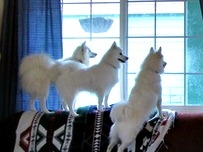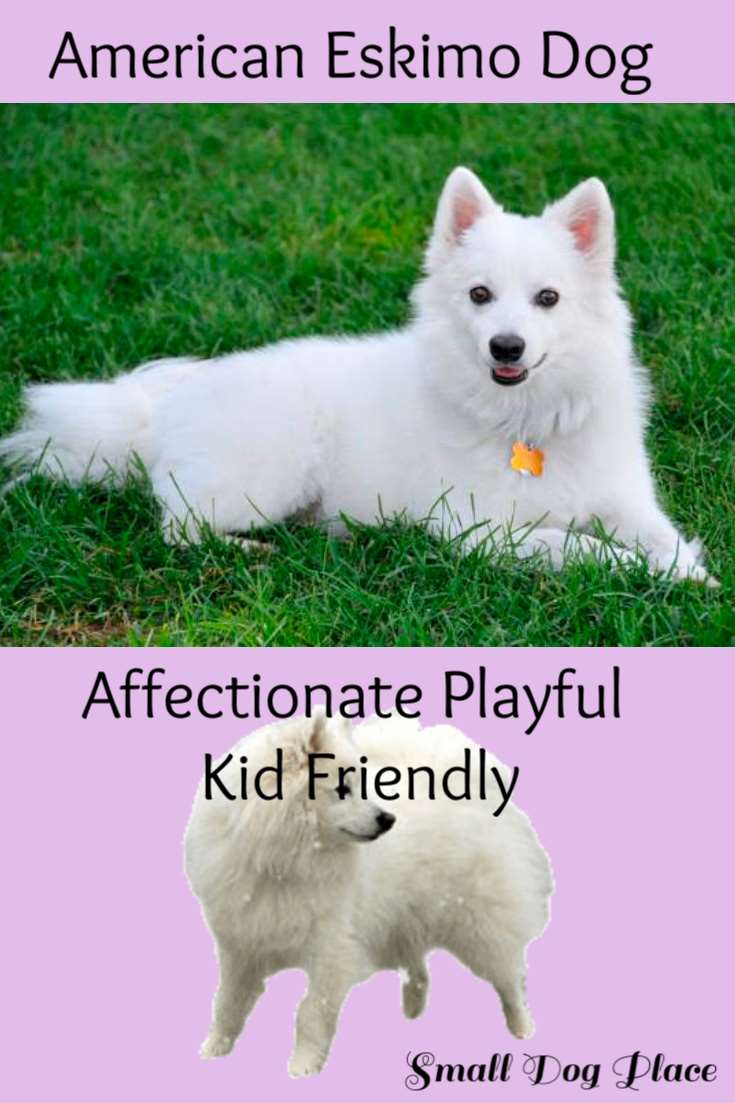- Small Dog Place Home
- A-Z Breeds A to M
- American Eskimo Dog
The American Eskimo Dog: Neither American, Nor Eskimo
by Janice Jones |Last Updated November 29, 2023
If intelligence and beauty are important to you, The American Eskimo dog can deliver. These fur babies, often affectionately referred to as Eskies are alert, trainable, loyal, and friendly.
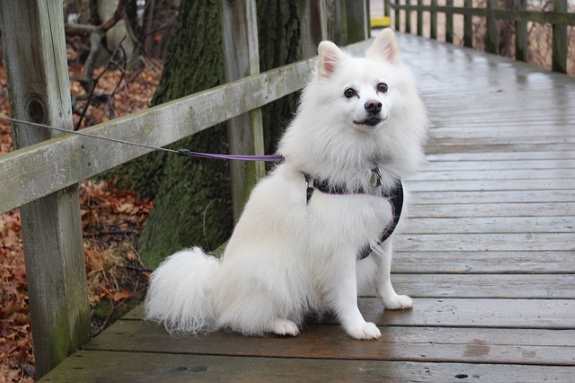 The American Eskimo Dog
The American Eskimo DogCould you ask for any more in a dog? Eskies love to play and
run around, but they also love to snuggle
and protect their owner(s).
Despite looking like a miniature Samoyed, the American Eskimo Dog is not a Nordic-type dog but does share some of the same features as one.
They have a stunning coat of hair, and distinct features on their face such as black lips, nose, and rim of their eyes.
The Eskie comes in three different sizes, much like the Poodle. These include a toy, miniature, and standard.
There are not many variations of these pups’ coats or color, but each Eskie has their own unique personality even if they all look similar.
The toy American Eskimo Dogs are a perfect size, weighing in at less than 10-pounds, which makes them the ideal lap dog and snuggle buddy.
This breed has many unique characteristics and sides to them, which make them very adaptable and suitable for a wide range of people.
If you’re looking for a versatile dog that is also highly intelligent, energetic, and loyal, then the American Eskimo Dog may be the perfect match and your new best friend.
Quick Facts
Other Names Used: Eskimo
Spitz, German Spitz, American Spitz, and Eskie
Affiliation: Non-Sporting group; AKC recognized in 1994, UKC, NKC
Size
Height: Toy: 9-12 inches
Weight: Toy: 6-10 pounds
Coat Type: Double Coat
Colors: White
Country of Origin: Germany
Activity Level: Moderate-High; this breed requires daily walks and exercise
Good with Children: If socialized and trained right, yes
Good with Other Pets: yes
History
The American Eskimo Dog was initially bred as companion dogs, despite the belief that they were developed to be sled dogs
Although they do look very similar to other Nordic-types, they do not share the desire to be sled dogs.
These guys are very closely related to the German Spitz, and despite their name, Eskies are neither American nor do they have anything to do with the Eskimo culture.
They originated in Germany and were brought to America by European immigrants.
Once they arrived in America during the 19th century, the American Eskimo Dog worked in circuses, walking on tightropes.
Circuses liked to utilize and highlight their agility, and they would even sell them to members of the audience, which was very controversial.
Personality
| Traits | Rating |
|---|---|
| Playfulness | |
| Affection Level | |
| Friendliness Towards Strangers | |
| Good with Children | |
| Good with Other Dogs | |
| Good for First Time Owners | |
| Exercise Needed | |
| Ease of Training | |
| Watch Dog Ability | |
| Grooming Requirements | |
| Shedding | |
| Cold Tolerant | |
| Heat Tolerant |
Dog Breed Ratings Got You a Little Confused?
Here's a little help in understanding them
- Playfulness: Most Playful = 5 Least Playful = 1
- Affection: Most Affectionate = 5 Least Affectionate = 1
- Friendliness Towards Strangers: Most Friendly = 5 Least = 1
- Good With Children: Great= 5 Not Good with Children = 1
- Good With Dogs: Great = 5 Not Good Around Dogs = 1
- Good With First Time Owners: Fine=5 Not Appropriate = 1
- Exercise Required: Extensive Daily Exercise = 5 Minimal = 1
- Ease of Training: Very Easy = 5 Difficult = 1
- Watch Dog: Excellent Watch Dog = 5 Minimal = 1
- Grooming: Time Consuming = 5 Minimal = 1
- Shedding: Heavy Shedder = 5 Minimal = 1
- Cold Tolerance: Well Tolerated = 5 Poor Tolerance = 1
- Heat Tolerance: Well Tolerated = 5 Poor Tolerance = 1
The Eskie was originally bred as a companion dog; however, they were also bred to guard people and property, making them excellent guard dogs.
They are also very territorial but are not considered an aggressive breed.
This particular breed is very loyal to their owners and follows in their footsteps, literally, making them the perfect shadow.
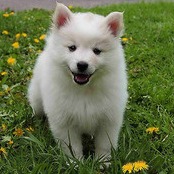 Courtesy CC Mitch D50
Courtesy CC Mitch D50Once they arrived in America during the 19th century, the American Eskimo Dog worked in circuses, walking on tightropes.
Circuses liked to utilize and highlight their agility, and they would even sell them to members of the audience, which was very controversial. American Eskimo DogCourtesy CC Mitch D50
Because they are very territorial, Eskies have the tendency to be vocal when a stranger comes around their owner or their owner’s property.
This breed is definitely smart and easily trainable, but they stay in their puppy stage for longer than almost any breed.
They take a while to mature and can carry puppy traits up until they are 2 years old, which is a year more than most breeds of dog.
They can suffer from severe separation anxiety or other misbehavior if they do not get the proper training from day one. They need to be socialized with children, pets, and other people if you want them to be on their best behavior around strangers.
Since they are intelligent and easily trainable, they pick up on new behaviors and tricks extremely quick and rank in the top breeds for agility competitions.
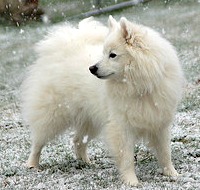 Courtesy CC Stefrobrts
Courtesy CC StefrobrtsEskies love to please but need to be in an environment with a firm, confident, and consistent pack leader.
Without this, they might think that they are the leader of the house, which can lead to behavior issues such as excessive barking, unnecessary aggression, etc.
They need a right amount of both mental and physical exercise, or they can become frantic and high-strung which could cause them to excessively spin in circles.
Suffering from Small Dog Syndrome is a real possibility for this breed.
Because they are small and cute, owners can tend to ignore the wrong behaviors, which can end up bad for the both of them in the long run.
They need daily exercise to help them release pent-up energy since they are such energetic dogs.
Being a very versatile breed, they can live almost anywhere from a large house to a small apartment.
They just like to be near their owner at all times. If you’re considering this breed and have babies in the house, the Eskie tends to start to worry when the baby starts crying.
They will worry until you let them know that there is nothing to be worried about. This is a unique characteristic of the American Eskimo Dog that could either be a good trait, or a bad trait, depending on your lifestyle and living conditions.
Grooming the American Eskimo Dog
Since the Eskie has a coarse double coat, they require a decent amount of grooming and brushing. You can take one look at them, and know that they need special attention when it comes to their coat.
Although they have a lot of hair, it’s easy to groom and brush and should be brushed at least twice a week, but daily when they are shedding. This breed is an average shedder, but they do not blow their coat.
A good pin brush will work well with this type of coat.
Along with the routine brushing, they need to have their eyes, ears, nails, and pads checked routinely also.
Hair continues to grow between the paw pads, and this can be trimmed with a small pair of blunt-tipped scissors.
This breed is prone to tear stains, which is when their tears gather under their eyes. This can be a breeding ground for bacteria and yeast though it is quite harmless. Try and keep this area clean to prevent discoloration.
Bathing is usually manageable with this breed. Before bathing, be sure to brush out any tangles or mats that have developed. Use a good quality shampoo and conditioner. Either dry the coat naturally or use a hair dryer on the cool setting. If the hair dries naturally, you will need to brush it out again after it is dry.
Health Concerns
This is a fairly healthy breed, but irresponsible breeding can cause hip and eye problems. If anything seems out of line, then contact your vet immediately just in case. Pay close attention to the tear stains and eyes.
Some may be allergic to fleas, so that is also something to keep in mind. This is a breed that can tend to be overweight if not given proper exercise. Be careful not to overfeed your Eskie. Other than that, this is a very healthy breed, but consider the following health concerns.
Pros:
- Easily trainable
- Amazing watchdog
- Generally healthy
- Protective of family
- Friendly and loyal
Cons:
- Can be vocal
- Allergies and tear staining are common
- Requires regular brushing and grooming
- Sheds regularly
- Some prone to separation anxiety
Additional Resources
Breed Club:
Rescue:
https://www.eskierescuersunited.org/
About Janice (author and voice behind this site)
Having lived with dogs and cats most of her life, Janice served as a veterinary technician for ten years in Maryland and twelve years as a Shih Tzu dog breeder in Ohio.
Her education includes undergraduate degrees in Psychology with a minor in biology, Early Childhood Education, and Nursing, and a master's in Mental Health Counseling.
She is a lifelong learner, a dog lover, and passionate about the welfare of animals. Her favorite breed for over 50 years has been the Shih Tzu, but she has also lived with poodles, Maltese, Yorkshire Terriers, beagles, English bulldogs, carin terriers, and a Cocker Spaniel.
When not writing, reading, and researching dog-related topics, she likes to spend time with her eight Shih Tzu dogs, husband, and family, as well as knitting and crocheting. She is also the voice behind Miracle Shih Tzu and Smart-Knit-Crocheting
Does This Article Deserve Your Thumbs Up?
We always appreciate your support and encouragement. Your thumbs up means so much to us. Please like this article.
If you find this page or any page on Small Dog Place Helpful, or useful in anyway, I'd love it if you would click the small heart found on the bottom right of each page.
You can also share or bookmark this page -- just click on the:

Free Monthly Newsletter
Sign Up for Our Free Newsletter and get our Free Gift to You.
my E-book, The Top 10 Mistakes People Make When Choosing a Dog (and how to avoid them)
